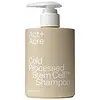What's inside
What's inside
 Key Ingredients
Key Ingredients

No key ingredients
 Benefits
Benefits

 Concerns
Concerns

 Ingredients Side-by-side
Ingredients Side-by-side

Water
Skin ConditioningDecyl Glucoside
CleansingSodium Lauroyl Lactylate
EmulsifyingParfum
MaskingGlycol Stearate
EmollientGlycerin
HumectantPanthenol
Skin ConditioningGuar Hydroxypropyltrimonium Chloride
Skin ConditioningButyrospermum Parkii Butter
Skin ConditioningHoney
HumectantTrichilia Emetica Seed Butter
EmollientAdansonia Digitata Seed Oil
EmollientFicus Carica Fruit/Leaf Extract
Skin ConditioningAloe Barbadensis Leaf Juice
Skin ConditioningHydrolyzed Rice Protein
Skin ConditioningCaprylyl Glycol
EmollientCaprylhydroxamic Acid
Stearamide Amp
Citric Acid
BufferingWater, Decyl Glucoside, Sodium Lauroyl Lactylate, Parfum, Glycol Stearate, Glycerin, Panthenol, Guar Hydroxypropyltrimonium Chloride, Butyrospermum Parkii Butter, Honey, Trichilia Emetica Seed Butter, Adansonia Digitata Seed Oil, Ficus Carica Fruit/Leaf Extract, Aloe Barbadensis Leaf Juice, Hydrolyzed Rice Protein, Caprylyl Glycol, Caprylhydroxamic Acid, Stearamide Amp, Citric Acid
Water
Skin ConditioningCocamidopropyl Betaine
CleansingSodium Methyl Cocoyl Taurate
CleansingGlycerin
HumectantBetaine
HumectantLactic Acid
BufferingPanthenol
Skin ConditioningSodium Benzoate
MaskingCaffeine
Skin ConditioningNiacinamide
SmoothingSodium Chloride
MaskingCoco-Glucoside
CleansingGlyceryl Oleate
EmollientSodium Gluconate
Skin ConditioningCocodimonium Hydroxypropyl Hydrolyzed Wheat Protein
CleansingHydrolyzed Rice Protein
Skin ConditioningHyaluronic Acid
HumectantIsomalt
HumectantBenzyl Alcohol
PerfumingPotassium Sorbate
PreservativeMalus Domestica Fruit Cell Culture Extract
Skin ConditioningTriethyl Citrate
MaskingJuniperus Virginiana Oil
MaskingAmyris Balsamifera Bark Oil
MaskingPogostemon Cablin Leaf Extract
PerfumingGamma-Nonalactone
MaskingIonone
AstringentElettaria Cardamomum Seed Oil
MaskingCistus Ladaniferus Resin Extract
Cananga Odorata Flower Oil
MaskingCaprylic/Capric Triglyceride
MaskingVanillin
MaskingViola Odorata Leaf Extract
MaskingHexenyl Acetate
MaskingAquilaria Agallocha Wood Oil
MaskingDimethylheptenal
PerfumingWater, Cocamidopropyl Betaine, Sodium Methyl Cocoyl Taurate, Glycerin, Betaine, Lactic Acid, Panthenol, Sodium Benzoate, Caffeine, Niacinamide, Sodium Chloride, Coco-Glucoside, Glyceryl Oleate, Sodium Gluconate, Cocodimonium Hydroxypropyl Hydrolyzed Wheat Protein, Hydrolyzed Rice Protein, Hyaluronic Acid, Isomalt, Benzyl Alcohol, Potassium Sorbate, Malus Domestica Fruit Cell Culture Extract, Triethyl Citrate, Juniperus Virginiana Oil, Amyris Balsamifera Bark Oil, Pogostemon Cablin Leaf Extract, Gamma-Nonalactone, Ionone, Elettaria Cardamomum Seed Oil, Cistus Ladaniferus Resin Extract, Cananga Odorata Flower Oil, Caprylic/Capric Triglyceride, Vanillin, Viola Odorata Leaf Extract, Hexenyl Acetate, Aquilaria Agallocha Wood Oil, Dimethylheptenal
 Reviews
Reviews

Ingredients Explained
These ingredients are found in both products.
Ingredients higher up in an ingredient list are typically present in a larger amount.
Glycerin is already naturally found in your skin. It helps moisturize and protect your skin.
A study from 2016 found glycerin to be more effective as a humectant than AHAs and hyaluronic acid.
As a humectant, it helps the skin stay hydrated by pulling moisture to your skin. The low molecular weight of glycerin allows it to pull moisture into the deeper layers of your skin.
Hydrated skin improves your skin barrier; Your skin barrier helps protect against irritants and bacteria.
Glycerin has also been found to have antimicrobial and antiviral properties. Due to these properties, glycerin is often used in wound and burn treatments.
In cosmetics, glycerin is usually derived from plants such as soybean or palm. However, it can also be sourced from animals, such as tallow or animal fat.
This ingredient is organic, colorless, odorless, and non-toxic.
Glycerin is the name for this ingredient in American English. British English uses Glycerol/Glycerine.
Learn more about GlycerinHydrolyzed Rice Protein is protein extracted from rice. This ingredient is rich in antioxidants and peptides.
Studies show this ingredient may help with blocking the melanin creation process when skin is exposed to UV.
Panthenol is a common ingredient that helps hydrate and soothe the skin. It is found naturally in our skin and hair.
There are two forms of panthenol: D and L.
D-panthenol is also known as dexpanthenol. Most cosmetics use dexpanthenol or a mixture of D and L-panthenol.
Panthenol is famous due to its ability to go deeper into the skin's layers. Using this ingredient has numerous pros (and no cons):
Like hyaluronic acid, panthenol is a humectant. Humectants are able to bind and hold large amounts of water to keep skin hydrated.
This ingredient works well for wound healing. It works by increasing tissue in the wound and helps close open wounds.
Once oxidized, panthenol converts to pantothenic acid. Panthothenic acid is found in all living cells.
This ingredient is also referred to as pro-vitamin B5.
Learn more about PanthenolWater. It's the most common cosmetic ingredient of all. You'll usually see it at the top of ingredient lists, meaning that it makes up the largest part of the product.
So why is it so popular? Water most often acts as a solvent - this means that it helps dissolve other ingredients into the formulation.
You'll also recognize water as that liquid we all need to stay alive. If you see this, drink a glass of water. Stay hydrated!
Learn more about Water